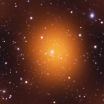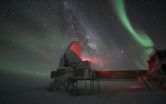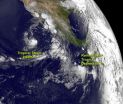(Press-News.org) Astronomers have found an extraordinary galaxy cluster — one of the largest objects in the universe — that is breaking several important cosmic records. The discovery of this cluster, known as the Phoenix Cluster, made with the National Science Foundation's South Pole Telescope, may force astronomers to rethink how these colossal structures, and the galaxies that inhabit them, evolve.
Follow-up observations made in ultraviolet, optical and infrared wavelengths show that stars are forming in this object at the highest rate ever seen in the middle of a galaxy cluster. The object also is the most powerful producer of X-rays of any known cluster, and among the most massive of clusters. The data also suggest that the rate of hot gas cooling in the central regions of the cluster is the largest ever observed.
Officially known as SPT-CLJ2344-4243, this galaxy cluster has been dubbed the "Phoenix Cluster" because it is located in the constellation of the Phoenix, and because of its remarkable properties. Scientists at the University of Chicago's Kavli Institute for Cosmological Physics and their collaborators initially found the cluster, located about 5.7 billion light years from Earth, using the Sunyaev-Zel'dovich effect, the shadow that the cluster makes in fossil light leftover from the big bang.
Predicted in 1972, the effect was first demonstrated to find previously unknown clusters of galaxies by the South Pole Telescope collaboration in 2009. Observations of the effect have since opened a new window for astronomers to discover the most massive, distant clusters in the universe.
"The mythology of the Phoenix — a bird rising from the dead — is a perfect way to describe this revived object," said Michael McDonald, a Hubble Fellow at the Massachusetts Institute of Technology's Kavli Institute for Astrophysics and Space Research. McDonald is the lead author of a paper appearing in the Aug. 16 issue of the journal Nature, which presents these findings. "While galaxies at the center of most clusters have been dead for billions of years, the central galaxy in this cluster seems to have come back to life," McDonald said.
Like other galaxy clusters, Phoenix holds a vast reservoir of hot gas that contains more normal matter than all of the galaxies in the cluster combined. The reservoir of hot gas can be detected with X-ray telescopes like NASA's Chandra X-ray Observatory, and the shadow it makes in the light from the big bang can be detected with the South Pole Telescope. The prevailing wisdom had once been that this hot gas should cool over time and sink to the center of the cluster, forming huge numbers of stars.
However, most galaxy clusters have formed very few stars over the last few billion years. Astronomers think that the supermassive black hole in the central galaxy of clusters pumps energy into the system, preventing cooling of gas from causing a burst of star formation. The famous Perseus Cluster is an example of a black hole bellowing out energy and preventing the gas from cooling to form stars at a high rate.
With its black hole not producing powerful enough jets, the center of the Phoenix Cluster is buzzing with stars that are forming 20 times faster than in the Perseus Cluster. This rate is the highest seen in the center of a galaxy cluster and is comparable to the highest seen anywhere in the universe.
The frenetic pace of star birth and cooling of gas in Phoenix are causing both the galaxy and the black hole to add mass very quickly — an important phase that the researchers predict will be relatively short-lived.
"The galaxy and its black hole are undergoing unsustainable growth," said co-author Bradford Benson, a Kavli Institute Fellow at UChicago. "This growth spurt can't last longer than about a hundred million years, otherwise the galaxy and black hole would become much bigger than their counterparts in the nearby universe."
Remarkably, the Phoenix Cluster and its central galaxy and supermassive black hole are already among the most massive known objects of their type. Because of their tremendous size, galaxy clusters are crucial objects for studying cosmology and galaxy evolution and so finding one with such extreme properties like the Phoenix Cluster is important.
"The beauty of the SZ effect for cosmology is that it is as easy to detect a cluster of galaxies in the distant reaches of the observable universe as it is for one nearby," said UChicago's John Carlstrom, the S. Chandrasekhar Distinguished Service Professor in Astronomy & Astrophysics. "The magnitude of the effect depends on the mass of the object and not its distance from Earth."
Galaxy clusters contain enough hot gas to create detectable "shadows" in the light left over from the big bang, which also is known as the cosmic microwave background radiation. This light has literally travelled for 14 billion years across the entire observable universe to get to Earth. If it passes through a massive cluster on its way, then a tiny fraction of the light gets scattered to higher energies — the Sunyaev-Zel'dovich effect.
The South Pole Telescope collaboration has now completed an SZ survey of a large region of the sky finding hundreds of distant, massive galaxy clusters. Further follow-up observations of the clusters at X-ray and other wavelengths may reveal the existence of additional Phoenix-like galaxy clusters.
INFORMATION:
Also contributing observations of the Phoenix Cluster were the Gemini Observatory and the Blanco 4-meter and Magellan telescopes, all in Chile, while several space-based telescopes were used to measure the cluster's star-formation rate.
Giant galaxy cluster sets record pace for star creation
2012-08-16
ELSE PRESS RELEASES FROM THIS DATE:
Designing tiny molecules that glow in water to shed light on biological processes
2012-08-16
CORAL GABLES, FL (August, 15, 2012)--University of Miami scientists have developed a way to switch fluorescent molecules on and off within aqueous environments, by strategically trapping the molecules inside water-soluble particles and controlling them with ultraviolet light. The new system can be used to develop better fluorescent probes for biomedical research.
Previous studies have used water-soluble particles to bring organic molecules into water. What is novel about this system is the use of a photoswitching mechanism in combination with these particles.
The findings ...
NSF's South Pole Telescope discovers a galaxy cluster creating stars at a record pace
2012-08-16
A National Science Foundation-funded radio telescope in Antarctica has found an extraordinary galaxy cluster that may force astronomers to rethink how galaxy clusters and the galaxies that inhabit them evolve.
The galaxy cluster was discovered some 5.7 billion light years from Earth by the 10-meter wide South Pole Telescope (SPT) located at NSF's Amundsen-Scott South Pole Station in Antarctica, which is funded by NSF's Office of Polar Programs.
NSF manages the U.S. Antarctic Program, through which it coordinates all U.S research and required logistical support on the ...
Lunar reconnaissance orbiter spectrometer detects helium in moon's atmosphere
2012-08-16
Scientists using the Lyman Alpha Mapping Project (LAMP) spectrometer aboard NASA's Lunar Reconnaissance Orbiter (LRO) have made the first spectroscopic observations of the noble gas helium in the tenuous atmosphere surrounding the Moon.
These remote-sensing observations complement in situ measurements taken in 1972 by the Lunar Atmosphere Composition Experiment (LACE) deployed by Apollo 17.
Although designed to map the lunar surface, the LAMP team expanded its science investigation to examine the far ultraviolet emissions visible in the tenuous atmosphere above the ...
NASA sees large Tropical Storm Kai-tak headed for a landfall near Hong Kong
2012-08-16
Warnings are still in effect in the northern Philippines and now in Hong Kong, as Tropical Storm Kai-tak continues to drop heavy rainfall and move toward a landfall in China. NASA's Aqua satellite captured infrared data that shows a large area of strong thunderstorms that make up Kai-tak.
NASA's Aqua satellite captured infrared data on Kai-tak when it passed overhead on August 15 at 0517 UTC (1:17 a.m. EDT/1:17 p.m. local time, Hong Kong). Forecasters at the Joint Typhoon Warning Center noted that infrared satellite imagery shows the organization near the center of Kai-tak's ...
Lunar Reconnaissance Orbiter's LAMP spectrometer detects helium in moon's atmosphere
2012-08-16
Scientists using the Lyman Alpha Mapping Project (LAMP) aboard NASA's Lunar Reconnaissance Orbiter have made the first spectroscopic observations of the noble gas helium in the tenuous atmosphere surrounding the Moon. These remote-sensing observations complement in-situ measurements taken in 1972 by the Lunar Atmosphere Composition Experiment (LACE) deployed by Apollo 17.
Although LAMP was designed to map the lunar surface, the team expanded its science investigation to examine the far ultraviolet emissions visible in the tenuous atmosphere above the lunar surface, detecting ...
GOES-15 satellite sees fading Tropical Storm Hector and TD7's remnants
2012-08-16
Two tropical cyclones were spotted from NOAA's GOES-15 satellite today, August 15. Tropical Storm Hector continues to weaken in the Eastern Pacific Ocean, while the remnants of the Atlantic Ocean's Tropical Depression 7 are moving over Central America. NASA's GOES Project, located at NASA's Goddard Space Flight Center, Greenbelt, Md., uses the GOES-15 satellite data to create images and animations from the satellite. The NOAA GOES-15 satellite sits in a fixed orbit over the eastern U.S. and provides infrared and visible imagery of the Eastern Pacific Ocean basin continuously. ...
Continuous oral contraceptive pills offer women earlier pain relief
2012-08-16
Taking oral contraceptives continuously, rather than as traditionally prescribed for each cycle, provides earlier relief for moderate to severe menstrual cramps -- dysmenorrhea -- according to researchers at Penn State College of Medicine.
Dysmenorrhea occurs during menstruation, resulting from abnormal uterine contractions, increased sensitivity to pain and added pressure in the pelvic area. It is often accompanied by nausea, vomiting, diarrhea, headache and fatigue.
"Between 50 and 90 percent of women suffer from this condition, and it can really limit work, school, ...
Astronomers reassured by record-breaking star formation in huge galaxy cluster
2012-08-16
This press release is available in Spanish.
Until now, evidence for what astronomers suspect happens at the cores of the largest galaxy clusters has been uncomfortably scarce. Theory predicts that cooling flows of gas should sink toward the cluster's center, sparking extreme star formation there, but so far – nada, zilch, not-so-much.
The situation changed dramatically when a large international team of over 80 astronomers, led by Massachusetts Institute of Technology's Hubble Fellow Michael McDonald, studied a recently discovered (yet among the largest-known) galaxy ...
Divorced couples' co-parenting relationships can improve, MU researcher says
2012-08-16
COLUMBIA, Mo. – New research conducted at the University of Missouri offers hope for divorced parents and suggests hostile relationships can improve when ex-spouses set aside their differences and focus on their children's needs.
"Most people falsely believe that, when people get divorced, they'll continue to fight, to be hostile," said Marilyn Coleman, Curators' Professor of Human Development and Family Studies at MU. "We found in our study that's not always true. Some couples get along from the very beginning, and, for about half of the women we interviewed, the couples ...
Tracking the effects of prenatal alcohol exposure through to 9 years of age
2012-08-16
Although studies of alcohol's effects on fetal growth have consistently demonstrated deficits that persist through infancy, the data on long-term postnatal growth from human studies have been inconsistent. A new study of the effects of heavy prenatal alcohol exposure (PAE) on growth and body composition throughout childhood has found growth restrictions that persist through to nine years of age, as well as a delay in weight gain during infancy, both of which were exacerbated by iron deficiency.
Results will be published in the November 2012 issue of Alcoholism: Clinical ...






